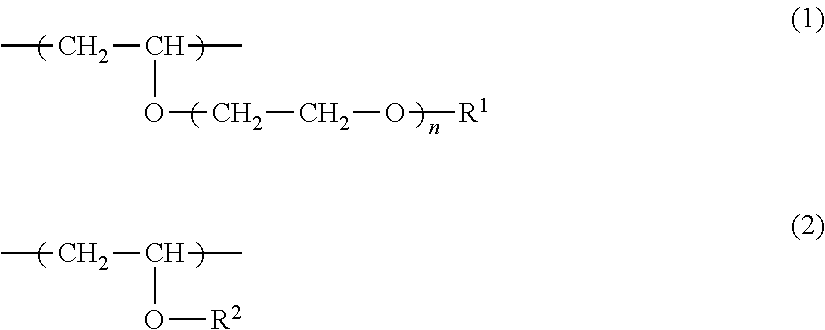Copolymer, antithrombotic coating agent using same and medical device
a technology of antithrombotic coating and copolymer, which is applied in the direction of packaging foodstuffs, packaged goods types, pharmaceutical containers, etc., can solve the problems of peeling or dissolution in use, limited improvement effect, and inability to increase the amount of hydrophobic components, etc., to achieve excellent antithrombotic properties, excellent film formation properties and resistance to water dissolution
- Summary
- Abstract
- Description
- Claims
- Application Information
AI Technical Summary
Benefits of technology
Problems solved by technology
Method used
Image
Examples
synthetic example 1
Synthesis of N-Butyl Vinyl Ether / Diethylene Glycol Monoethyl Monovinyl Ether Random Copolymer (NBVE-Ran-EOEOVE):
[0073]Into a 300-mL three neck flask with a three-way stopcock previously subjected to dewatering with heat at 300° C. under dry nitrogen atmosphere for 10 minutes, 181 mL of toluene as a solvent, 76.4 mL of ethyl acetate as an added base, 4.0 mL of diethylene glycol monoethyl monovinyl ether (EOEOVE) as a hydrophilic vinyl ether, 28.2 mL of N-butyl vinyl ether (NBVE) as a hydrophobic vinyl ether, 4 mM (0.45 mL) of an acetic acid adduct of isobutyl vinyl ether as an initiator species were added, and the mixture was stirred well.
[0074]Next, the flask was kept at 0° C., and 8 mM (8.8 mL) of Et1.5AlCl1.5 was added as a Lewis acid catalyst to start polymerization, and a reaction was carried out for 90 minutes.
[0075]The polymerization was stopped by methanol containing a small amount of sodium methoxide (1 M). To the solution in which the reaction stopped, 5% by mass of an ion ...
synthetic examples 2 to 14
[0077]Copolymers A, B, D to N shown in Table 1 were produced by performing synthesis based on Synthetic Example 1 while using EOEOVE or TEGVE as a hydrophilic vinyl ether and using NBVE or tricyclodecanyl vinyl ether (TCDVE) as a hydrophobic vinyl ether and varying the amount of the initiator species and the composition ratio. The resulting copolymers were evaluated for the solubility in water by the same operation as in Synthetic Example 1. The composition ratio, molecular weight (Mw), molecular weight distribution (Mw / Mn), and solubility in water of each copolymer are shown in Table 1.
synthetic examples 15 to 17
[0078]Homopolymers O, P, and Q shown in Table 1 were produced by polymerizing each of EOEOVE, NBVE, and TCDVE alone based on Synthetic Example 1. The resulting homopolymers were evaluated for the solubility in water by the same operation as in Synthetic Example 1. The evaluation results of the molecular weight (Mw), molecular weight distribution (Mw / Mn), and solubility in water of each homopolymer are shown in Table 1.
TABLE 1Hydro-SampleChemicalphilic unitMw / Solubility innamename(mol %)MwMnwater (25° C.)ANBVE-ran-1034001.43InsolubleBEOEOVE42001.48InsolubleC115001.12InsolubleD147001.11InsolubleE243001.16InsolubleF2036001.20InsolubleG117001.14InsolubleH141001.10InsolubleI233001.08InsolubleJNBVE-ran-1099001.10InsolubleTEGVEKNBVE-block-10146001.12InsolubleTEGVELTCDVE-ran-30352001.15InsolubleTEGVEMTCDVE-block-30441001.09InsolubleTEGVENTEGVE-block-30117001.14InsolubleNBVE-block-TEGVEOEOEOVE100116001.21SolublePNBVE0252001.14InsolubleQTCDVE0296001.08Insoluble
(Solubility in Water)
[0079]Insol...
PUM
| Property | Measurement | Unit |
|---|---|---|
| temperature | aaaaa | aaaaa |
| temperature | aaaaa | aaaaa |
| molar ratio | aaaaa | aaaaa |
Abstract
Description
Claims
Application Information
 Login to View More
Login to View More - R&D
- Intellectual Property
- Life Sciences
- Materials
- Tech Scout
- Unparalleled Data Quality
- Higher Quality Content
- 60% Fewer Hallucinations
Browse by: Latest US Patents, China's latest patents, Technical Efficacy Thesaurus, Application Domain, Technology Topic, Popular Technical Reports.
© 2025 PatSnap. All rights reserved.Legal|Privacy policy|Modern Slavery Act Transparency Statement|Sitemap|About US| Contact US: help@patsnap.com



